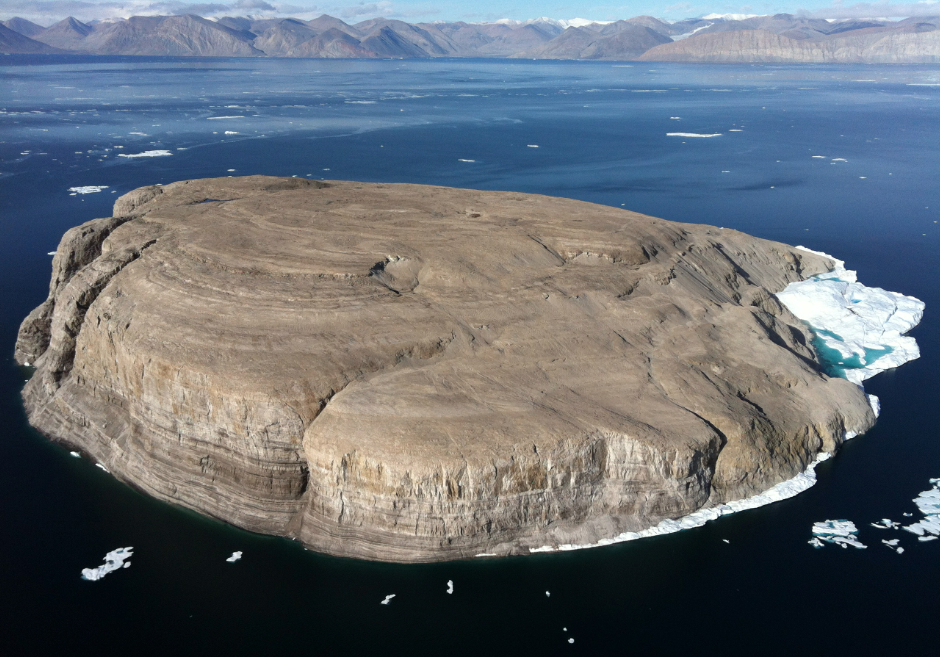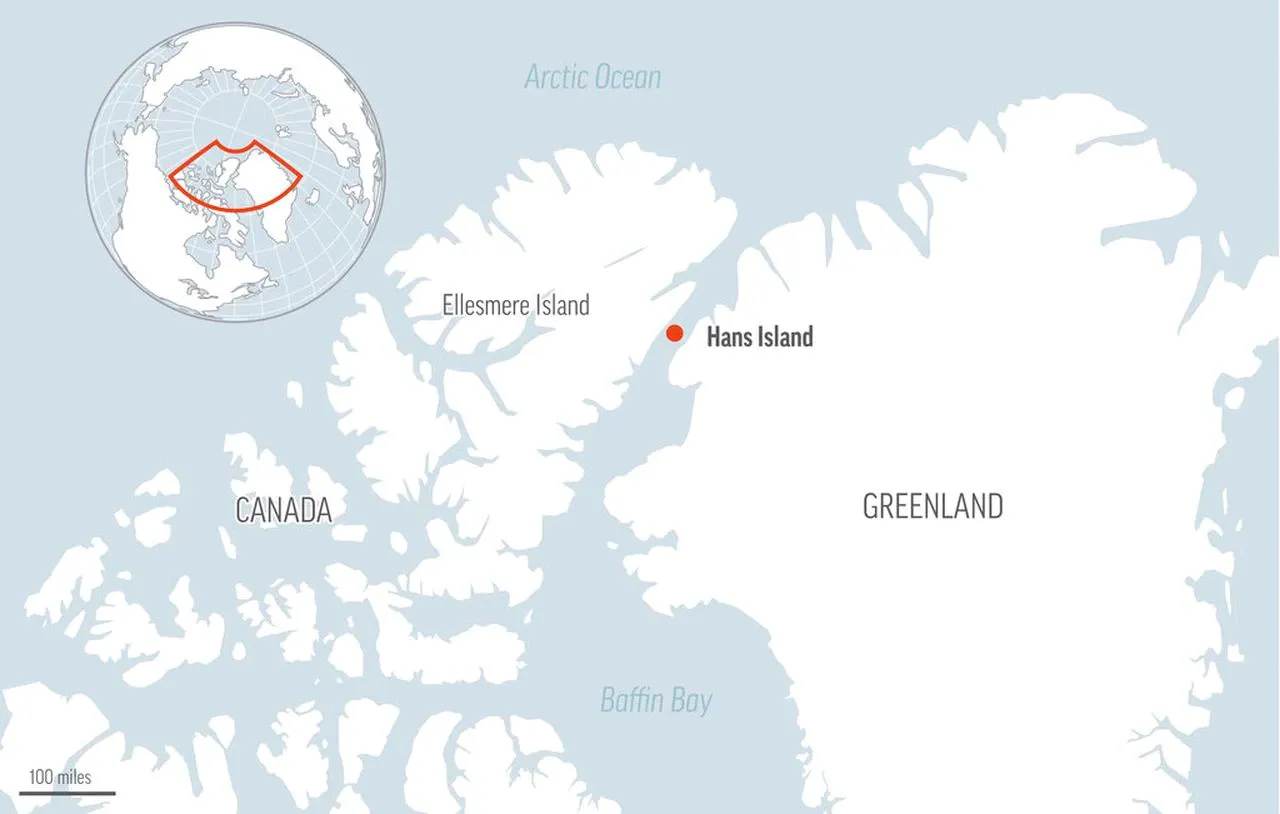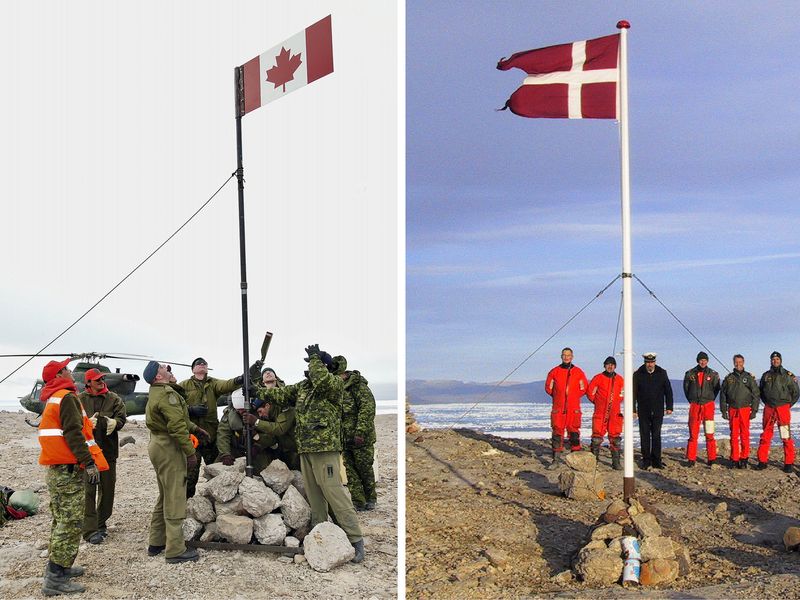A War By Which To Gauge All Others - CANADA/DENMARK
Never have Canadians been so involved with a particular war as when it has been trading blows with the Scandinavian country of Denmark in the late 20th Century. Since Canada drew up an up-to-date border map in 1973, Hans Island has been the source of bloody outrage.
I'm kidding. This is about Canadian and Danish behavior. Not Russian.
I mean verbal outrage in the war of words and antics between Denmark and Canada. It became known as The Whiskey War.
The dispute over Hans Island (Tartupaluk in Inuktitut and Greenlandic) began in 1973 when Canada and Denmark attempted to draw a boundary through the Nares Strait and found both countries could credibly lay claim to the island, which is roughly equidistant to both Canada and Greenland. Greenland is part of the Realm of Denmark, and it seemingly made sense that both sides had 'some' claim to Hans Island.

Professor Michael Byers of the University of British Columbia noted in his testimony before the Senate that: “There’s only one dispute over land in the entire Arctic, and that is a small island between Canada and Greenland named Hans Island. It is 1.3 square kilometers. It is a dispute that only involves the island and not the water or the seabed around it because those issues were resolved in a boundary treaty between Canada and Denmark in 1973. So, it is a small dispute with a very close military and trading partner.
"Therefore, in my view, it’s almost insignificant."
—Professor Michael Byers
We have two maritime boundary disputes, one of them to the north of Hans Island in the Lincoln Sea, which is so small as to also be nearly irrelevant.”
I've been proud for the balance of my life that the Canadian armed forces were called “Peacekeepers,” following the 1948 establishment of that UN force at the initiation of future Canadian prime minister and Nobel Peach Prize recipient Lester Pearson. Canadian forces often found themselves babysitting a warzone under the guise of a treaty or ceasefire. It was often dangerous and dirty work. But it came with gratitude to the powers engaged in disputes and the countries involved, even if on occasion it failed.
Canada did little to soil its post-WWII standings as a world leader in peacekeeping. Except when Canada, along with 18 other countries led by the USA, did mess up the Koreas together. The Canadian flag still stands in Panmunjom in North Korea where the armistice was signed, where they see the flag as that of a belligerent. Lest we forget... there's always someone to remind you of the wrongs you did. But Canada’s armed forces have generally been a trustworthy force for good in the world--principled and motivated towards fairness.
Not a drop of blood has been spilled in the war between Denmark and Canada; if anything got spilled it would relate to alcohol has been consumed as a way to negotiate through this epic dispute. The famed war, which drew its conclusive day of reckoning in June 2022, was characterized by its outbreaks of peaceful aggressions and thoughtful notes. The bloodless conflict became known as the “Whiskey War” because, beginning in the 1980s, Canada and Denmark routinely took turns staking their claim to the island by removing the other nation’s flag and planting that of their own and leaving behind sheltered bottles of liquor for the opposing forces to enjoy when next they came to remove the other’s flag replant their own— whiskey from Canada, schnapps from Denmark.
“I think it was the friendliest of all wars,” said Canadian foreign minister Mélanie Joly, praising the diplomatic work that went into resolving the 50-year dispute. The resulting treaty is “a win for Canada, a win for Denmark and Greenland, and a win for Indigenous Peoples,” she added.
The 2011-2020 Danish Arctic Strategy noted “the disagreement is handled professionally, as it should happen between two neighboring countries and close allies.” It should be noted that while Canada and Denmark sparred over Hans Island, they continued to be close allies and conducted joint missions and exercises elsewhere, including in Afghanistan, Iraq, and Ukraine.
LOCATOR MAP

The historic accord divides the 1.2-square-kilometer barren island roughly in half, creating a land border between Canada and Denmark (Greenland, or Kalaallit Nunaat, is an autonomous country within the Kingdom of Denmark) and the world’s longest maritime boundary at nearly 4,000 kilometers. It also ensures Inuit in both countries will be able to move freely about the island and surrounding ice and waters, an important hunting ground since the 14th century.
In the 50 murky years of war between Canada and Denmark, countless lives were spent enjoying schnapps and whiskey and faxing off border possibilities to each other. As both sides near running dry of story supplies and verbal artillery, a treaty was signed and the scrub uninhabited island was split in half, giving Canada another borderland neighbor, Denmark!
It would be nice if world domination, leapfrogging over war zones, endlessly drawn-out conflicts, oceans of blood, carpet bombing, and land mines, could take a page or two from the historical dispute between Canada and Denmark - and maybe Russia could try and get the Donbas Region by helicoptering in a crate of Russia's finest vodka, and we could give peace a chance. Or Zelenskyy could leave a case of Ukraine’s native Horilka(essentially just vodka and nastoianka for flavoring).
“I know that today's era is not the era for war,”
—Indian Prime Minister Narendra Modi
They say that “in the fog of war” little truths and unintended consequences often get lost or misrepresented or go without being reported. Here’s one not to be overlooked as an unintended outcome of the Whisky War. My 14-year-old nephew Riley, fond of geography, pointed out a small list of “countries that only had one land border with another country – and now that list is shortened from 19 to 17 with the truce of former members Canada/Denmark. Riley found this list of “countries” with just one land-border from www.worldatlas.com:
“There are at least seventeen sovereign countries globally that only share international border lines with one other country. Some of these countries are landlocked while others have a coastline.” the site clarifies that such countries sharing their border with only one neighbor include Timor-Leste, South Korea, Qatar, Monaco, Portugal, Papua New Guinea, Haiti, and the Dominican Republic.
Never let it escape you that wars are all power grabs and body counts, neither Canada nor Denmark exhibited bad vibes; if only this war was to be the 21stCentury war, a battle for principles and fairness, a war done with words.
sources:
National Geographic
Wikipedia
BBC.com
Washington Post
worldatlas.com
WION
Library of Congress - ISSN 2691-6592

